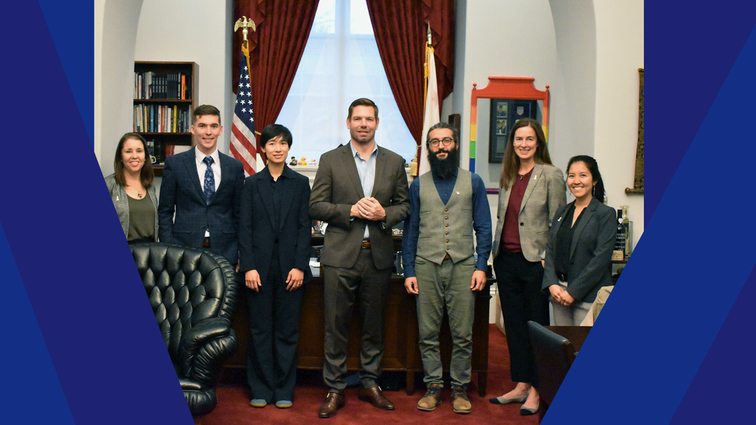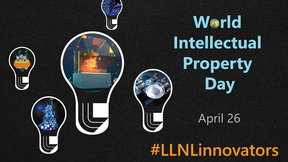Energy I-Corps experience shines light on bringing specialty resin to the silicone 3D-printing market
 (Download Image)
(Download Image)
Lab scientists Michael Ford and Sijia Huang (second and third from the left) gave a presentation about their Energy I-Corps experience and research to Rep. Eric Swalwell (center). Also shown are Danielle France of the National Renewable Energy Laboratory (far left) and to the right of Swalwell, Yiğit Mengüç, the Lab scientists’ mentor; Shelly Curtiss, the Energy I-Corps program manager; and Carolina Villacis, commercialization program manager for the Office of Technology Transitions.
In the fall of 2023, Lawrence Livermore National Laboratory (LLNL) scientists Sijia Huang and Michael Ford participated in the Department of Energy’s Energy I-Corps Program, an immersive eight-week entrepreneurial boot camp that teaches scientists and engineers the tools of the trade for commercializing technology from the Lab to the marketplace.
A major part of the program’s curriculum required participants to “get out of the building” and conduct interviews with prospective customers to determine how their technology can become a commercial product.
“It is important to talk to people and learn about their challenges. It might seem obvious, but you can’t solve anything with your assumptions about what problems people are having. You have to go out and talk to them and really dig deep to learn what their problems are,” Ford said.
At LLNL, Huang and Ford are working toward developing a new method to make high-performance silicone parts that can be 3D printed and cured using ultraviolet light.
Based on their interviews with members of industry, the team — aptly named PhotoSil — anticipates that this process could revolutionize the production of complex silicone components as well as create capacity for local manufacturing.
However, like Vincent van Gogh once said, “great things are not done by impulse, but by a series of small steps,” the team is doing a similar thing. Instead of going straight to company launch or aimlessly searching for a licensing partner without a commercialization plan, the researchers participated in the Energy I-Corps program where they learned how to perform market research and identify where in the marketplace their technology would have the best chance of being adopted.
One of the advantages of participating in Energy I-Corps is partnering up with an industry mentor, who could share their business experience and insights.
Yiğit Mengüç, who previously worked at Meta as a project manager, helped keep the team stay grounded as well as identify what made them excited about working on their technology. They also learned what aspects of the technology would be important for the 3D printing industry.
Within the 3D printing ecosystem, there are many important players including the material producers, the printer and resin distributors, all the way to the prototyping service providers and the end-user of the 3D printed parts.
Working with Mengüç, the PhotoSil team determined that their initial product would be targeting service providers that make custom components for engineers who are prototyping or desiring silicone parts at relatively low volumes, such as fewer than 10,000 parts.
Aimed to interview one to two dozen representatives
To verify that their assumptions for their product and target market are sound, the scientific duo set off to interview around one to two dozen representatives from each of the four groups that are in the 3D printing ecosystem to get their feedback on whether a business with their product is desirable, feasible and viable.
To gain experience and confidence, initial calls were to supportive contacts, friends and colleagues in industry. It wasn’t too long before their interviews became less daunting and easier to complete as they honed their message, questions and delivery.
“The key lesson we took away from the I-Corps program is the value of networking. Though intimidating at first, reaching out via cold emails and engaging with strangers proved immensely beneficial. By interacting with people from diverse parts of the advanced manufacturing industry, we gained valuable insights and knowledge,” Huang said.
Based on information they collected from 77 interviews, which included contacts from domestic and international companies, the LLNL researchers were able to determine the scale at which printing will likely be feasible to meet market needs. They also gained a deeper understanding of applications that would benefit from their technology, including personalized architectures and component-on-demand manufacturing as well as interesting use-cases that the researchers hadn’t identified, like components for food processing.
In addition to teleconferencing and phone calls, the research team also had the opportunity for in-person meetups. Ford visited Nexa3D, a maker of 3D printers in Ventura, California, where he toured their facilities and learned about their unique capabilities that allow them to rapidly produce components to move toward manufacturing — not just prototyping — with 3D printing.
While at a scientific conference in Minneapolis last October, Huang also took the opportunity to hop a few blocks over to visit the expo floor of the annual Advanced Manufacturing Minneapolis event. It was very fortuitous that the conferences were happening concurrently since Huang was able to explore essentially five tradeshows in one venue and network with a cross-section of engineers, business executives and decision-makers from not just the 3D printing space, but also aerospace and defense, medical design and robotics.
A visit to the Mayo Clinic
The highpoint of the Minneapolis visit, according to Huang, was her tour of the prestigious Mayo Clinic, which has its own 3D printing laboratory. This on-site facility prints models for surgeons and radiologists so they can plan out surgeries before ever entering the operating room.
To wrap up their I-Corps experience, the PhotoSil team was invited to Washington D.C. for their capstone graduation. Their D.C. trip included touring the Department of Energy (DOE) office building and the Capitol building.
There, the Energy I-Corps program had arranged a meeting for the team to visit their local representative and share their research. Huang and Ford visited Eric Swalwell, the U.S. representative for California’s 14th District at his office, where they reprised their elevator pitch for PhotoSil and talked about their Energy I-Corps experience.
As a token of recognition for their efforts to move LLNL technology beyond the confines of the Lab, each team member received a challenge coin from Swalwell.
So, what’s next for the research team behind PhotoSil? On their roadmap to commercialization that the team created during the program, the next step is technology maturation. One of the challenges that the scientists face is that their technology readiness level is still low, meaning more development resources are needed before commercialization can be a reality.
This is where LLNL’s Laboratory Directed Research and Development Program or partnering up with an external collaborator could help. If funding can be secured, Ford and Huang would be able to add a couple more members to the team and continue the momentum that was generated by their participation in the Energy I-Corps program.
Since 2015, nearly 20 LLNL engineers and scientists have gone through the Energy I-Corps program to learn how to apply business and entrepreneurial skills to their research projects. The next call for applications will be released in the spring for teams to participate in the program in early fall. For more information, contact farquar3 [at] llnl.gov (Hannah Farquar).
While the Energy I-Corps program is funded by the DOE Office of Technology Transitions, the participation of LLNL’s Ford and Huang in the program was funded by the National Nuclear Security Administration.
Contact
 Stephen Wampler
Stephen Wampler
[email protected]
(925) 423-3107
Related Links
Lab Innovation and Partnerships OfficeEnergy I-Corps Program
Tags
Physical and Life SciencesCommunity Outreach
Economic Impact
Government
Industry Collaborations
Materials Science
Featured Articles







